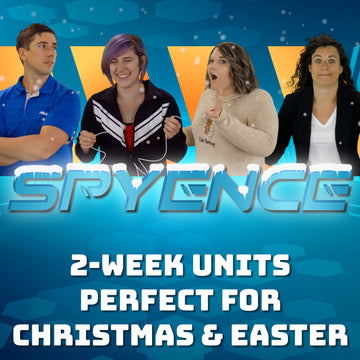Fun Kids’ Church Videos That Teach Deep Theology
Watch These Examples – You’ll Get It Right Away
Example #1: Teaching Kids About Firstfruits
Firstfruits is a farming term that means “the first fruit or the first grain that you pick during harvest time.”
The firstfruits of the harvest was a sign that the rest of the harvest was coming soon.
Just like the firstfruits are a promise of more to come, Jesus’ resurrection is God’s promise that all believers will be raised someday.
In this Spyence episode, Chris learns how this important theology concept applies to our lives today.
Example #2: Teaching Kids About Biblical Application
Application means that when you read the Bible and learn what God wants you to do, you do it.
When Emily wrestles with the meaning of life, Secret Agent K points her to Jesus' words in Luke 11:28: “But even more blessed are all who hear the word of God and put it into practice.”
What does that mean?
Let's see how Secret Agent K unpacks that verse for Emily.
Example #3: Teaching Kids About Evidence That God Exists
In Systematic Theology, the term Evidence means “clues that God is real.”
In this episode, Chris sets out to build the God-Prover-3000 to prove that God is real, only to discover the evidence is all around him: the beauty of creation, Jesus’ miracles, the vastness of the universe, and the truth of the resurrection.
By the end, kids know they don’t have to see God to believe in Him—His fingerprints are everywhere.
🎯 Try two free theology lessons with videos
Your kids are already theologians. Let’s make sure they’re good ones.
SPYENCE VIDEOS: WHERE THEOLOGY MEETS STORYTELLING
The Challenge
Kids have big questions: Why did Jesus have to die? How do I know God is real? Will I go to heaven?
The challenge is teaching these deep theological truths in a way that keeps even your most energetic 5th-grade boys glued to their seats.
Spyence Kids' Church Curriculum uses high-energy, edge-of-their-seats video content to teach theology in a way kids remember.
Gospel-Centered Videos That Stick
Spyence's Gospel-centered videos aren’t just entertaining—they’re designed to teach and reinforce:
• Deep theological terms and concepts, in kid-friendly language
• Real-life application modeled by characters kids love
• Positive role models for boys & girls
Every segment is designed so kids don’t just hear the truth—they remember it all week long.
Lasers, Gadgets… and Sanctification
When super-fan Kiki finally meets her laser-shooting heroes Victoria & Emily and their gadget-guy Chris, she gushes, “This is the most exciting thing ever!”
Victoria gently corrects her: “No… the most exciting moment in history was when God came to earth as a human.”
This fun interaction explains the incarnation in a way kids feel—showing that Jesus becoming human changes everything.
Superheroes, Robots, & Justification
In one high-stakes mission, Victoria and Emily are trapped in an Evil Robot’s force field. They blast, push, and struggle—but nothing works.
That’s when Secret Agent K steps in. She uses the moment to explain that justification is not about our effort, but what Christ has done on the cross for us.
By the end, kids watch their heroes stop fighting to “earn” the win and instead rely on the one who’s already secured the victory.
For Leaders Who Want More Than Fluff
If you’ve been searching for a video-enhanced children’s ministry curriculum that’s fun AND theologically rich, you know the struggle – many resources are either deep but dull, or exciting but shallow.
Spyence bridges that gap with deep theology and high production-value videos.
Point Kids to Jesus–Without Sacrificing Depth or Fun
Spyence gives you ready-to-use, volunteer-friendly lessons with engaging videos that grab kids’ attention while faithfully teaching Scripture.
That means less prep for you, more engagement from your team, and a Sunday experience that points kids to Jesus without sacrificing depth for entertainment.
Example #4: Teaching Kids About The Resurrection
Resurrection means “coming back to life in your own body.”
The Bible teaches that Jesus didn’t just die for our sins – He rose again on the third day to offer eternal life to everyone who believes in Him as their Savior.
What does that mean? Was Jesus a ghost? Did He still eat food? Could He fly?
Watch as Victoria & Emily help their friends understand Jesus’ resurrection and how it changes everything for us.
Example #5: Teaching Kids About Baptism
Baptism is a picture of what we believe about Jesus.
When someone is baptized, they’re showing others that they believe Jesus died and was buried (pictured by going under the water) and that Jesus was raised from the dead (pictured by coming up out of the water).
Kids often wonder – does baptism save me? In Spyence, the answer comes through a memorable mission that makes it clear: baptism doesn’t save us—Jesus does—but it’s an important way to follow Him.
Example #6: Teaching Kids About Justification
Justification means that God declares us righteous, or “right with Him.”
The hardest part for kids to grasp is that Jesus did it all for us. We don't have to work for our salvation. Instead, we need to put our trust in Jesus' finished work on the cross.
So... how do you get kids thinking about this concept?
Introduce it in a Superheroes vs. Evil Robots video like this...
READY TO BRING SPYENCE TO YOUR KIDS’ MINISTRY?
Big Truth. Big Fun. Zero Boredom.
1: Are Kids Ready to Learn Theology?
Kids ask big questions: “Why did Jesus have to die?” “How do I know God is real?” “Will I go to heaven?”
YES! Kids are ready to learn theology.
The real challenge? Teaching deep truths in a way that keeps even your wiggliest 5th-grade boys glued to their seats.
That’s where Spyence comes in.
2: Can Videos Really Help Kids Learn Theology?
YES! Every Spyence video is designed to do more than entertain—it’s built to weave deep theological truths into a storyline kids want to watch.
These short video segments aren’t the whole lesson, but they give you memorable teaching moments that kids remember all week.
Take a peak behind the curtain at how Spyence sneaks theology into short, fun video segments that augment the teacher's lesson.



